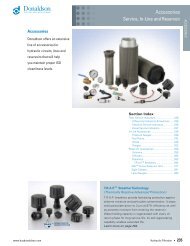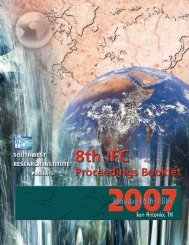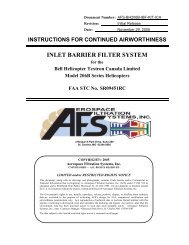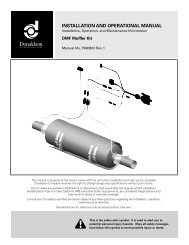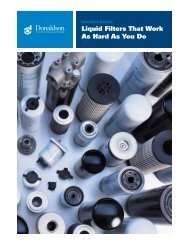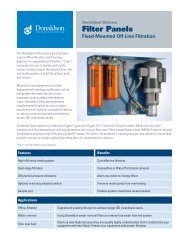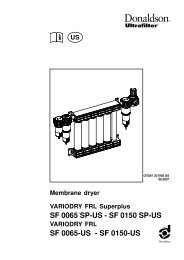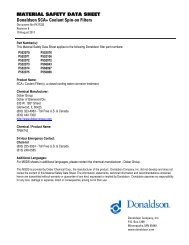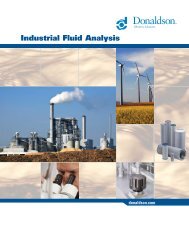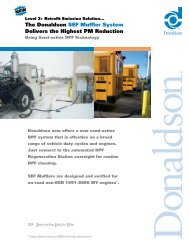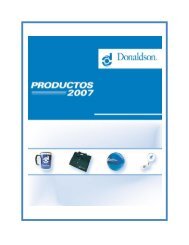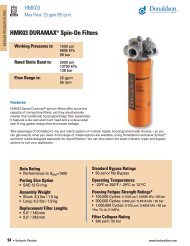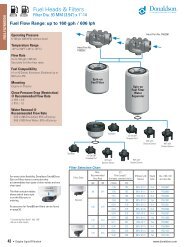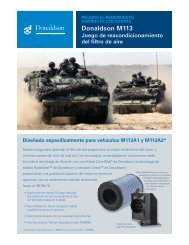Hydraulic Filtration Technical Reference - Donaldson Company, Inc.
Hydraulic Filtration Technical Reference - Donaldson Company, Inc.
Hydraulic Filtration Technical Reference - Donaldson Company, Inc.
You also want an ePaper? Increase the reach of your titles
YUMPU automatically turns print PDFs into web optimized ePapers that Google loves.
How Filter Media Functions<br />
In a <strong>Filtration</strong> System<br />
The job of the media is to capture particles and allow<br />
the fluid to flow through. For fluid to pass through, the<br />
media must have holes or channels to direct the fluid<br />
flow and allow it to pass. That’s why filter media is a<br />
porous mat of fibers that alters the fluid flow stream<br />
by causing fluid to twist, turn and accelerate during<br />
passage.<br />
The fluid changes direction as it comes into contact<br />
with the media fibers, as illustrated above. As the<br />
fluid flows through the media, it changes direction<br />
continuously as it works its way through the maze of<br />
media fibers. As it works its way through the depths<br />
of the layers of fibers, the fluid becomes cleaner and<br />
cleaner. Generally, the thicker the media, the greater<br />
the dirt-holding capacity it has.<br />
Looking at a cross-<br />
section view of the fibers,<br />
we can see how the<br />
flowstream is accelerated<br />
as it flows into the spaces<br />
between the fibers.<br />
www.buydonaldson.com<br />
<strong>Technical</strong> <strong>Reference</strong><br />
How Filter Media Collects Particles<br />
There are four basic ways media<br />
captures particles.<br />
The first, called inertia, works on large, heavy<br />
particles suspended in the flow stream. These<br />
particles are heavier than the fluid surrounding them. As<br />
the fluid changes direction to enter the fiber space, the<br />
particle continues in a straight line and collides with the<br />
media fibers where it is trapped and held.<br />
The second way media can capture particles is<br />
by diffusion. Diffusion works on the smallest<br />
particles. Small particles are not held in place<br />
by the viscous fluid and diffuse within the flow stream.<br />
As the particles traverse the flow stream, they collide<br />
with the fiber and are collected.<br />
The third method of particle entrapment is call<br />
interception. Direct interception works on particles<br />
in the mid-range size that are not quite large enough to<br />
have inertia and not small enough to diffuse within the<br />
flow stream. These mid-sized particles follow the flow<br />
stream as it bends through the fiber spaces. Particles<br />
are intercepted or captured when they touch a fiber.<br />
The fourth method of capture is called sieving<br />
and is the most common mechanism in hydraulic<br />
filtration. As shown at right, this is when the particle<br />
is too large to fit<br />
between the fiber<br />
spaces.<br />
<strong>Hydraulic</strong> <strong>Filtration</strong> • 335<br />
HYDRAULIC FILTRATION - TECHNICAL REFERENCE



